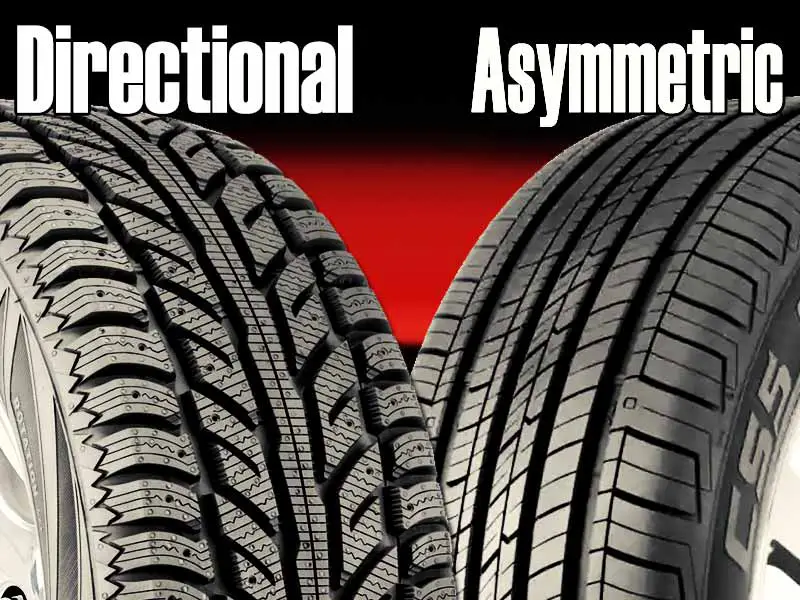Directional tires need to be mounted in the same direction and should be rotated with care as well to make sure that any one of these does not get mounted in reversed direction.
For identification of the tire type, these tires have characteristic tread designs and their sidewalls also carry a marking showing that the tire is directional.

Table of Contents
What are directional tires?
Directional tires (also called unidirectional tires) have tread patterns pointing in one direction.
Their tread elements are usually arranged in a V or Y shaped orientation.
Most often lateral grooves are more prominent in these tires than longitudinal channels and tend to meet in the center of the tire.
How to identify directional tires?
An easy method to tell if your tires are directional or not is to check the sidewall of the tires.
Most directional tires have a marking saying “direction” or “rotation” with an arrowhead pointing in the forward direction.
This is the direction in which you should mount these tires on your vehicles.
Another way you can identify them is to see the tread pattern carefully.
If tread elements are arranged in a V-pattern or point in one direction then your tire is directional.
How to rotate directional tires?
Being unidirectional these tires can only be mounted in one direction marked at their sidewall. If you put them otherwise, you would not get the desired traction.
Likewise, these tires must be rotated carefully as you can rotate them on both sides of the vehicle. Instead, only tires of one side can be rotated with each other.
You can put the front tire in the rear position and the rear one in the front, that’s all!
This restriction is because if you put them on the other side of the car, their direction would be reversed.
However, if you compulsively want to rotate tires on opposite sides, you need to demount them from wheels and get remounted in the reversed direction before putting them on the other side of the car.
In this way, you can prevent the wrong fitment.
But this task is quite technical and most probably you would need to get it done at a service station rather than on your own.
Benefits of directional tires:
Directional tires come with many benefits over non-directional tires which are listed as follows;
- These tires provide better hydroplaning resistance as water easily flows through their inclined grooves. Due to this feature, their wet traction especially handling ability on the water-covered road is enhanced.
- The off road tires with directional tread patterns perform well in mud and snow terrains. This is because loose substances like soft snow, slush, or mud are smoothly channeled outward from the tread through their streamlined lateral grooves.
- Another benefit that comes with these tires is high directional stability i.e. these tires maintain firm traction when you are traveling in one direction at a high speed. That is why most high performance and sports vehicles have directional tires. High directional stability also provides the benefit of decreased rolling resistance and minimized fuel consumption.
What if you put a directional tire backwards?
If you mount directional tires in the reversed direction, you would still be able to drive but the performance of the tire would be reduced.
- When these tires are mounted in the wrong direction. Their hydroplaning resistivity is markedly reduced as the orientation of water channeling voids is reversed. Resultantly, water is not pushed backward and its flow through tread channels becomes turbulent.
- Handling efficiency and precision of steering response are also reduced by reversed fitment.
- Also, when the tire rolls in the direction opposite to its pattern, it faces more rolling resistance and the tread wears faster. As more energy is consumed in this way, fuel efficiency is also lowered.
- Another disadvantage that comes with the opposite orientation of the grooves is the increased noise production as sound waves collide and resonate among disoriented grooves rather than dampening down in streamlined channels.
Directional tires vs Non-directional tires:
| Directional Tires | Non directional tires |
| Tread elements point in one direction | Tread elements have a multidirectional orientation |
| Can be mounted in one direction only | You can mount them in any direction |
| Rotation is possible only upon one side of the vehicle | These tires can be rotated on both sides of the car without any performance decline |
| Are more expensive in comparison | Cost relatively lesser |